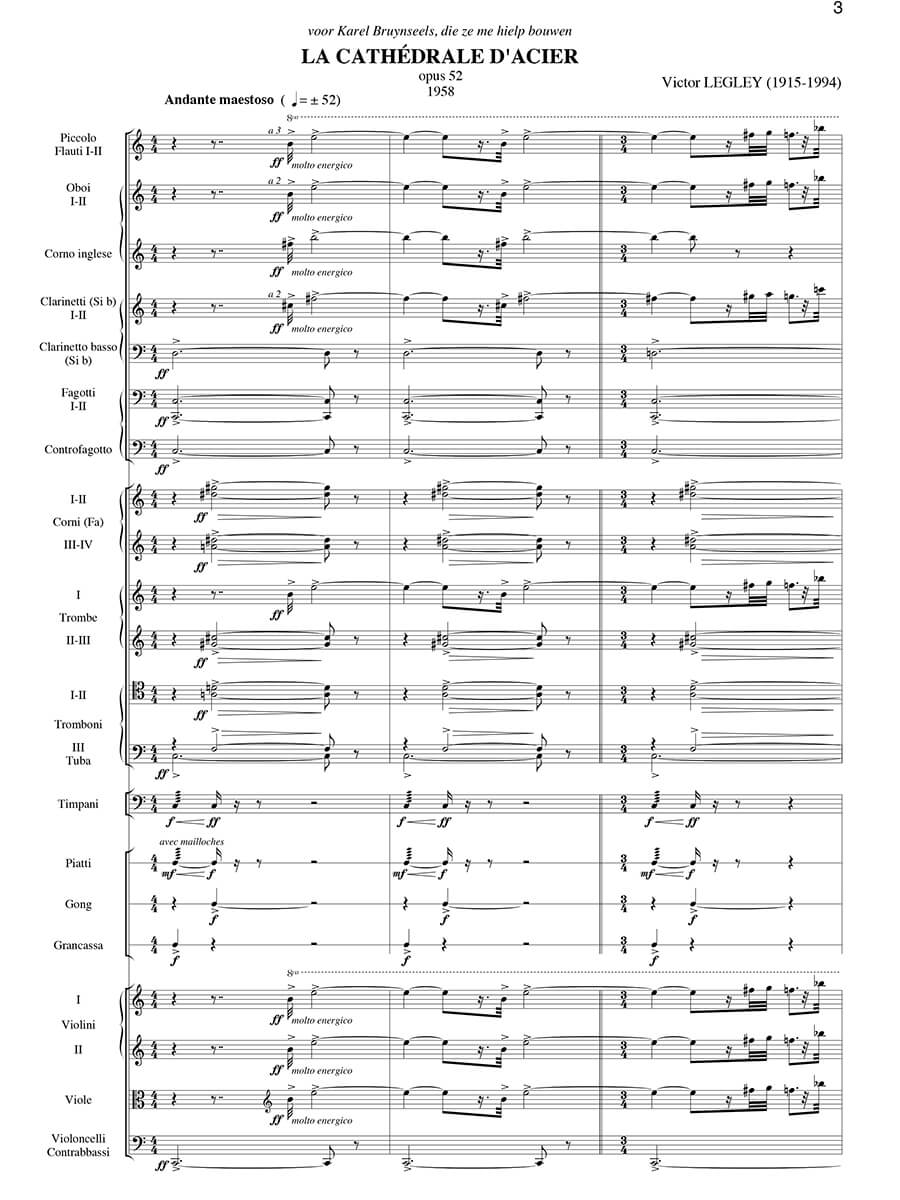La Cathédrale d’acier, opus 52, esquisse symphonique d’après un tableau de Fernand Steven (first print)
Legley, Victor
24,00 €
Victor Legley – La Cathédrale d’acier, opus 52
(Hazebroek, 18 June 1915 – Oostende, 28 November 1994)
esquisse symphonique d’après un tableau de Fernand Steven
(1958)
La Cathédrale d’acier is a symphonic work from 1958 that is characteristic of Legley’s oeuvre. It represents an important part of his way of thinking, his philosophy and his aesthetics. This symphonic poem was performed for the first time on 10 April 1959 in Brussels, by the symphonic orchestra of the former Nationaal Instituut voor de Radio-omroep (NIR), conducted by Daniel Sternefeld. The piece is about twelve minutes long.
Legley himself described his composition as follows: ‘This symphonic evocation was born out of the figurative content of the painting. The scene presented by the Liège painter [Fernand Steven] shows a steel cathedral, rising from the ruins of an old church, with in its shadow a human being. The symbolism is clear.
The contradiction can be seen clearly in the symphonic scheme, consisting of a three-part movement: a static intro [Andante maestoso, bar 1-19]; a turbulent middle part driven by a dynamic rhythm and urged on by climaxes alternating with expressive-melodic features [Allegro molto energico, ma non troppo vivo, bar 20-158]; an alleviating finale, carried by soft horn sounds and contemplating clarinet interventions [Adagio, bar 159-246]. This did not result in descriptive music. The composer transposes his overall impression in a score defined by expressionist compactness, an orchestral density and a concentric design.’
As is common in Legley’s pieces from circa 1945 onwards, La Cathédral d’acier also contains a synthesis of the old and the new. On the one hand he follows an old tradition: he gives his work a clear-cut and transparent form. There is always a melodic line, he uses counterpoint, he works with a limited number of recognizable motifs, and harmonically his composition is set within a larger tonal framework. On the other hand, Legley does not want to deny the fact that he is a twentieth-century composer: he often uses dissonance and unexpected chords, and his melodic lines are clearly influenced by dodecaphony (for example, the first theme in the first violin (bar 1-10) uses all twelve notes of the chromatic scale, often repeating the same notes however).
That being said, Legley does not go as far as his more radical contemporaries, Boulez, Goeyvaerts and Stockhausen: he only uses the horizontal, melodic aspect of the dodecaphony or serialism, never its vertical, harmonic aspect. Judging from Legley’s articles, radio broadcasts and speeches, it is clear that he was well-informed on the many avant-garde movements of his time. He respected these movements but did not want to apply them himself. The radical break with the past that had taken place after the Second World War was an aesthetic disaster in his eyes. In this way, La Cathédral d’acier is an expression of Legley’s criticism of many musicians of his time. He thought it was important to continue what was created in the past and to strive for beauty (in the painting this is symbolised by the church). According to him, the steel cathedrals of avant-garde music cared too little for the listener and did not connect with the audience, something that was of major importance to Legley. He wanted to create pieces that brought joy, not just spark people’s interest.
On top of that, after his earliest period of creation, composition had to be profound according to Legley. It had to express the existence and presence of humanity. This meant he gave voice to deep feelings, ones that were not always positive. Just like his contemporaries, Legley was deeply affected by the two world wars, so in his compositions there was very little room for sensuality and lust. Doubt, fear, anguish and aggression are often at the front, but at the same time there is room for good moods, enthusiasm, energy, understanding, faith, forgiveness and sublimation, feelings that can all be found in La Cathédral d’acier.
Ronald de Roeck (summary: Koenraad Sterckx)
translation: Jasmien Dewilde
This introduction is a very brief summary of an article by Ronald de Roeck: Victor Legley: Some notes on his thoughts and Cathédrale d’acier, in Anuario Musical, nr. 65, 2010, p. 171-196. The article contains, among other things, an extensive analysis of La Cathédrale d’acier and is available online:http://anuariomusical.revistas.csic.es/index.php/anuariomusical/article/view/117/118.
This score was published in collaboration with the Study Centre for Flemish Music (www.svm.be). Orchestra material is available through the library of the Royal Conservatoire of Brussels (bib.kcb@ehb.be). Koenraad Sterckx edited the score based on the autograph. Critical comments can be consulted on http://wiki.muziekcollecties.be
Read full Flemish preface > HERE
| Score No. | |
|---|---|
| Special Edition | |
| Genre | |
| Size | |
| Printing | |
| Pages |
